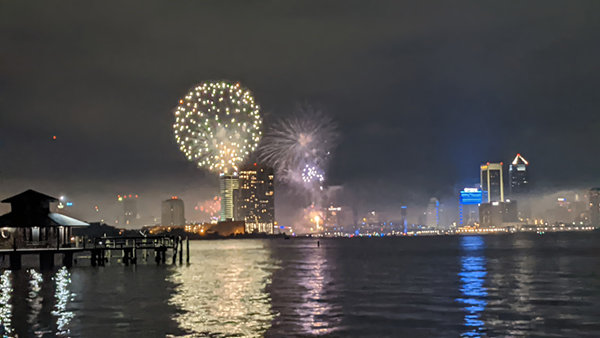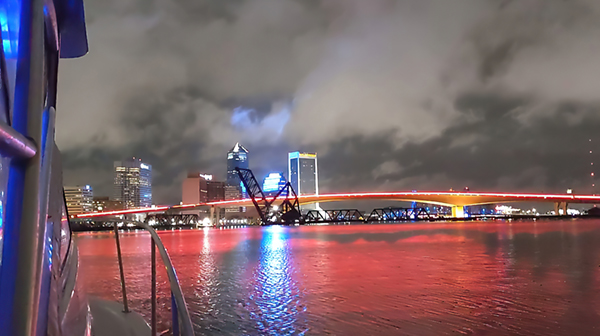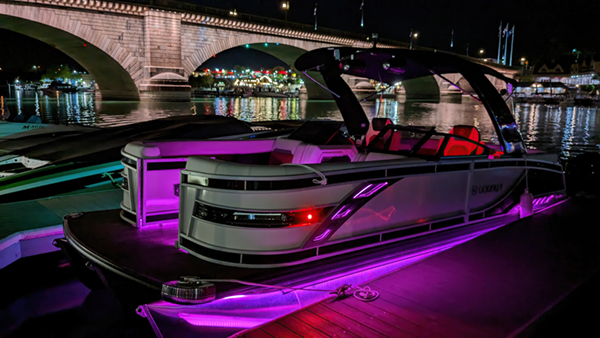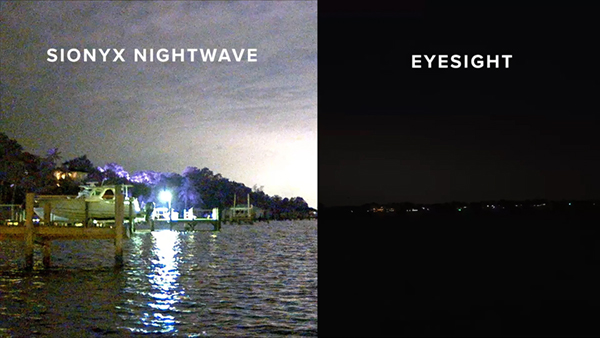Night-time boating is a surreal, magical experience but requires extra vigilance for a safe voyage.
Whether you are just continuing the day on the water past sunset or shoving off the dock when it’s dark, night-time boating makes the experience more of an adventure. The plusses are many: it’s cooler, there’s less traffic, it’s quieter, and the vibe is different than daytime boating. It’s also a bit more complicated, but with some preparation and knowledge, it’s well worth it.

Safety First
Before leaving the dock, the driver should give a safety briefing. Encourage the use of Coast Guard compliant personal flotation devices (PFDs) and ensure each has a signaling device like a whistle. Make sure at least one other person on board can drive the boat. If not, teach the basics of boat operation in case the driver becomes incapacitated. Because of reduced visibility, enlist the help of all to keep watch and report anything to the driver they may have missed, such as a boat overtaking your boat or an object floating in the water. Let friends on land know where you are going and when you intend to return, then follow up with a phone call when you return.
While the driver should abstain from any alcohol, it’s downright dangerous to have anyone on board who has had too much to drink. If you find a guest has been overserved, the best thing to do is cut the trip short and head back to the dock. Of course, you don’t have to say that’s why you are returning; do it without fanfare.

Display the Correct Lights
The US Coast Guard has established rules that mandate what navigation lights should be displayed so other boaters can see a boat and determine its orientation to their relative position and direction of travel. At night, a boat must display sidelights: a red light on the port side (left) and a green light on the starboard side (right) that shines from dead ahead to 112.5 degrees on each side. In addition, depending on the size of the vessel, display either a white stern light that shines 135 degrees rearward or a masthead light that’s at least 1 meter above the sidelights that shines 360 degrees.
Are Other Lights Legal?
One of the growing trends in boating is the use of decorative LED lights both above the surface and underwater. Contrary to the beliefs of some, the US Coast Guard has not outlawed these lights unless they interfere with the visibility of required navigation lights or the ability of the driver to maintain watch.
Bright spreader lights or flashing stereo speaker lights can distract other boaters and are a guaranteed night vision killer. But soft interior mood lights look good and improve the safety of those aboard. While underwater lighting and underdeck lighting for pontoon boats can enhance a boat’s visibility, blue lights, combined with wave action, could be mistaken for law enforcement emergency lights and should be avoided when running.

Visibility Dictates Speed
Besides posted speed limits, no statute prohibits a boat driver from operating a boat at planing speeds and higher even if they can’t see the water ahead. But if
you do this often enough, the law of averages says your boat will hit something eventually. Common sense dictates running at idle speeds on moonless nights if you can’t see the water ahead. But even when it’s dark, there are ways to help boaters see and other devices that can help prevent collisions.
Another benefit of traveling slowly is that it’s easier to break out the food and do some snacking while cruising. Keep the fare simple and have items that aren’t messy, like cheeses and meats, with toothpicks serving as utensils. Even in the summer, it can get chilly on the water, so have a few blankets handy if anyone gets cold.
.jpg)
Night Vision Assets
Night vision cameras such as the color Sionyx Nightwave® collect starlight and magnify it to allow drivers to see well enough to run on plane safely at night. Forward-looking infrared cameras like the FLIR® M232 “see” in the dark by measuring and displaying minute thermal differences between an object and its surroundings.
This camera can also pan and tilt, giving it 360-degree coverage. Another massive help to navigation and collision avoidance is radar units like the Simrad® Halo20 dome unit that can track boats on an intersect course and identify hazards like unlit channel markers. If you live in an area with lots of commercial traffic like fishing boats, consider upgrading your VHF to a model like the Standard Horizon® GX2200 that has an AIS receiver that acts like a radar to track surrounding vessels that are broadcasting AIS signals. The last aid to navigation is a spotlight, which boaters should use sparingly to avoid blinding other boaters. Save it for the last few feet of docking at your home port if it’s dark.
Navigating in the Dark
Even if you know an area like the back of your hand, everything looks different at night. It’s easy to mistake one set of lights for another, so drivers must use a GPS to navigate. Turn on your GPS unit when leaving the dock so you have a trail leading back home on the screen, like the breadcrumbs in Hansel and Gretel. However, since anything electrical can fail, spend a few minutes staring back when you leave to understand better what your home port looks like at night. Most phones have a GPS navigation system that can serve as a backup.
Check the Weather Before Leaving
Nothing will disrupt the serenity of an evening cruise like the appearance of a sudden storm. Visibility at night is bad enough, but add rain, wind and lightning, and it can get downright scary, even for seasoned drivers. Always check the weather in advance and get updates throughout the evening. If there is a risk of fog, it’s better to hold your floating soirée at the dock instead of venturing out.
A night-time cruise is a fantastic way to expand your boating day and have more fun on the water. And taking the necessary precautions will make it memorable for the right reasons.
Back to Blue Life
Whether you are just continuing the day on the water past sunset or shoving off the dock when it’s dark, night-time boating makes the experience more of an adventure. The plusses are many: it’s cooler, there’s less traffic, it’s quieter, and the vibe is different than daytime boating. It’s also a bit more complicated, but with some preparation and knowledge, it’s well worth it.

Safety First
Before leaving the dock, the driver should give a safety briefing. Encourage the use of Coast Guard compliant personal flotation devices (PFDs) and ensure each has a signaling device like a whistle. Make sure at least one other person on board can drive the boat. If not, teach the basics of boat operation in case the driver becomes incapacitated. Because of reduced visibility, enlist the help of all to keep watch and report anything to the driver they may have missed, such as a boat overtaking your boat or an object floating in the water. Let friends on land know where you are going and when you intend to return, then follow up with a phone call when you return.
While the driver should abstain from any alcohol, it’s downright dangerous to have anyone on board who has had too much to drink. If you find a guest has been overserved, the best thing to do is cut the trip short and head back to the dock. Of course, you don’t have to say that’s why you are returning; do it without fanfare.

Display the Correct Lights
The US Coast Guard has established rules that mandate what navigation lights should be displayed so other boaters can see a boat and determine its orientation to their relative position and direction of travel. At night, a boat must display sidelights: a red light on the port side (left) and a green light on the starboard side (right) that shines from dead ahead to 112.5 degrees on each side. In addition, depending on the size of the vessel, display either a white stern light that shines 135 degrees rearward or a masthead light that’s at least 1 meter above the sidelights that shines 360 degrees.
Are Other Lights Legal?
One of the growing trends in boating is the use of decorative LED lights both above the surface and underwater. Contrary to the beliefs of some, the US Coast Guard has not outlawed these lights unless they interfere with the visibility of required navigation lights or the ability of the driver to maintain watch.
Bright spreader lights or flashing stereo speaker lights can distract other boaters and are a guaranteed night vision killer. But soft interior mood lights look good and improve the safety of those aboard. While underwater lighting and underdeck lighting for pontoon boats can enhance a boat’s visibility, blue lights, combined with wave action, could be mistaken for law enforcement emergency lights and should be avoided when running.

Visibility Dictates Speed
Besides posted speed limits, no statute prohibits a boat driver from operating a boat at planing speeds and higher even if they can’t see the water ahead. But if
you do this often enough, the law of averages says your boat will hit something eventually. Common sense dictates running at idle speeds on moonless nights if you can’t see the water ahead. But even when it’s dark, there are ways to help boaters see and other devices that can help prevent collisions.
Another benefit of traveling slowly is that it’s easier to break out the food and do some snacking while cruising. Keep the fare simple and have items that aren’t messy, like cheeses and meats, with toothpicks serving as utensils. Even in the summer, it can get chilly on the water, so have a few blankets handy if anyone gets cold.
.jpg)
Night Vision Assets
Night vision cameras such as the color Sionyx Nightwave® collect starlight and magnify it to allow drivers to see well enough to run on plane safely at night. Forward-looking infrared cameras like the FLIR® M232 “see” in the dark by measuring and displaying minute thermal differences between an object and its surroundings.
This camera can also pan and tilt, giving it 360-degree coverage. Another massive help to navigation and collision avoidance is radar units like the Simrad® Halo20 dome unit that can track boats on an intersect course and identify hazards like unlit channel markers. If you live in an area with lots of commercial traffic like fishing boats, consider upgrading your VHF to a model like the Standard Horizon® GX2200 that has an AIS receiver that acts like a radar to track surrounding vessels that are broadcasting AIS signals. The last aid to navigation is a spotlight, which boaters should use sparingly to avoid blinding other boaters. Save it for the last few feet of docking at your home port if it’s dark.
Navigating in the Dark
Even if you know an area like the back of your hand, everything looks different at night. It’s easy to mistake one set of lights for another, so drivers must use a GPS to navigate. Turn on your GPS unit when leaving the dock so you have a trail leading back home on the screen, like the breadcrumbs in Hansel and Gretel. However, since anything electrical can fail, spend a few minutes staring back when you leave to understand better what your home port looks like at night. Most phones have a GPS navigation system that can serve as a backup.
Check the Weather Before Leaving
Nothing will disrupt the serenity of an evening cruise like the appearance of a sudden storm. Visibility at night is bad enough, but add rain, wind and lightning, and it can get downright scary, even for seasoned drivers. Always check the weather in advance and get updates throughout the evening. If there is a risk of fog, it’s better to hold your floating soirée at the dock instead of venturing out.
A night-time cruise is a fantastic way to expand your boating day and have more fun on the water. And taking the necessary precautions will make it memorable for the right reasons.
Back to Blue Life
